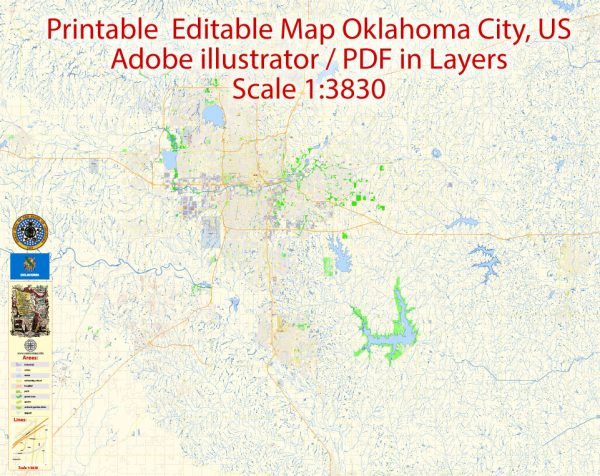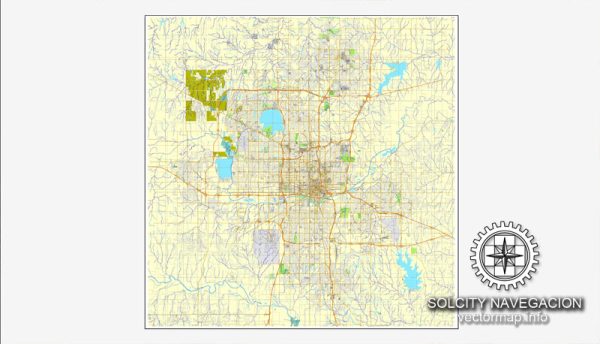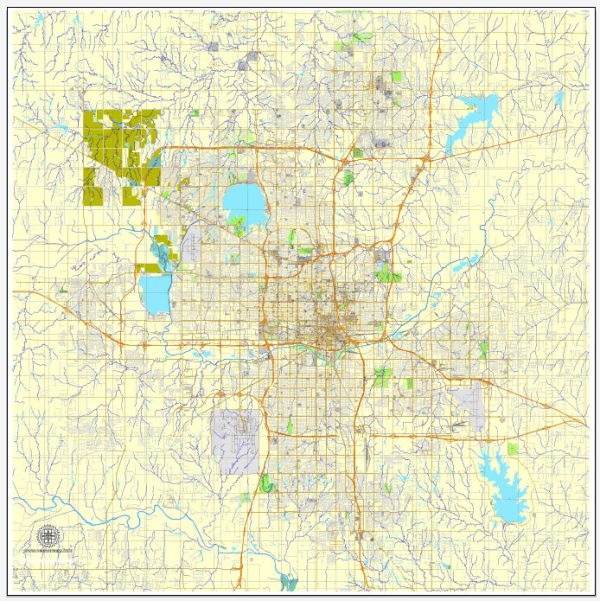Oklahoma City, the capital of the state of Oklahoma in the United States, has a rich history that reflects the broader trends of westward expansion, Native American displacement, and the development of the American frontier.
Vectormap.Net provide you with the most accurate and up-to-date vector maps in Adobe Illustrator, PDF and other formats, designed for editing and printing. Please read the vector map descriptions carefully.
Here’s a detailed overview of the urban history and street system of Oklahoma City:
Early History:
- Land Allotments: The area that would become Oklahoma City was originally part of the Indian Territory, reserved for Native American tribes forcibly relocated from their ancestral lands. The federal government later opened this land to non-Indigenous settlement through the Land Run of 1889.
- Land Run of 1889: On April 22, 1889, thousands of settlers lined up at the borders of the unassigned lands, waiting for the signal to race in and claim their piece of land. This event marked the founding of Oklahoma City, and within hours, a tent city emerged, with makeshift structures and businesses.
Early Development:
- Growth and Incorporation: Oklahoma City grew rapidly, and by 1890, it was officially incorporated as a city. The city quickly developed as a trading and transportation hub, serving as a key point along cattle trails and later benefiting from the arrival of the railroad.
- Oil Boom: The discovery of oil in the early 20th century further fueled the city’s growth. Oklahoma City became a center for the oil industry, attracting businesses, workers, and capital.
Urban Expansion and Street System:
- Grid System: Like many cities in the Midwest and West, Oklahoma City was laid out in a grid pattern. The city streets follow a numbered and lettered grid system, making navigation relatively straightforward.
- Downtown Development: The central business district, or downtown, became a focal point for commercial and civic activities. The construction of prominent buildings, including the Skirvin Hotel and the Oklahoma State Capitol, reflected the city’s growing prominence.
- Urban Renewal: In the mid-20th century, Oklahoma City, like many American cities, experienced urban renewal projects. These efforts aimed to revitalize downtown areas but often led to the demolition of historic buildings. Notable examples include the construction of the Myriad Gardens and the Pei Plan, which redesigned the central business district.
Recent Developments:
- MAPS Initiative: In the 1990s, Oklahoma City implemented the Metropolitan Area Projects (MAPS) initiative. This series of projects aimed to enhance the city’s quality of life, including the construction of the Bricktown Canal, the Chesapeake Energy Arena, and improvements to public spaces.
- Devon Energy Center: The Devon Energy Center, completed in 2012, stands as one of the city’s modern landmarks. This skyscraper reflects both economic development and a commitment to sustainable architecture.
- Revitalization Efforts: Ongoing efforts focus on revitalizing neighborhoods, preserving historic structures, and promoting cultural amenities. The city continues to evolve, with initiatives aimed at enhancing livability and attracting businesses.
Challenges and Opportunities:
- Infrastructure: Like many growing cities, Oklahoma City faces challenges related to infrastructure, traffic, and public transportation. Efforts are ongoing to address these issues and plan for sustainable urban development.
- Community Engagement: The city places importance on community engagement and involvement in planning processes. Various community organizations and initiatives work towards fostering a sense of inclusivity and collaboration among residents.
In summary, Oklahoma City’s urban history is deeply rooted in westward expansion, land settlement, and economic booms, particularly in the oil industry. The city’s street system, with its grid layout, reflects the practical considerations of efficient urban planning. Over the years, Oklahoma City has experienced both challenges and successes, and its ongoing development is shaped by a mix of historical legacy and contemporary initiatives aimed at creating a vibrant and sustainable urban environment.




 Author: Kirill Shrayber, Ph.D.
Author: Kirill Shrayber, Ph.D.